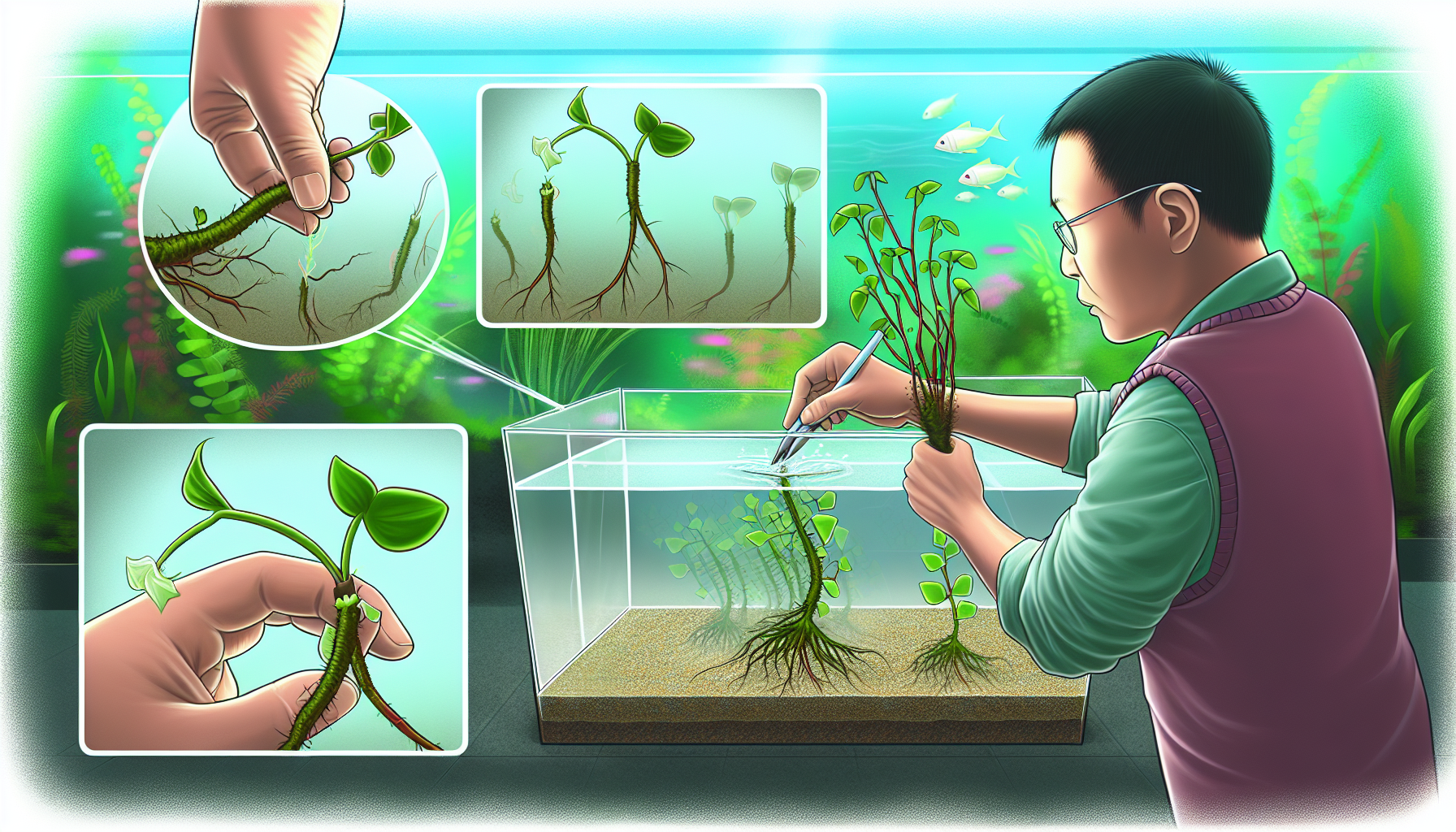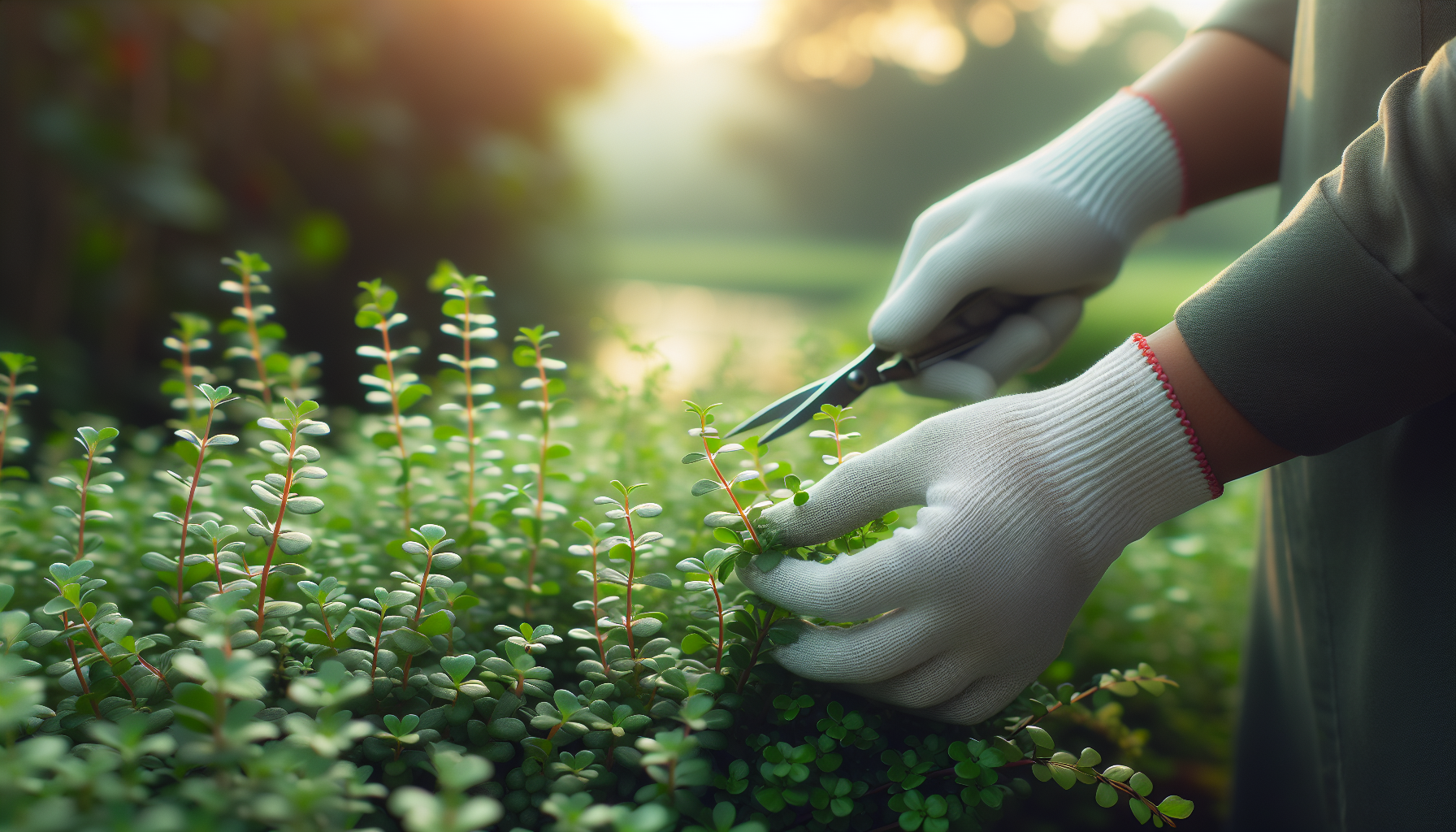Bacopa Caroliniana: Tips for Growing Lush Thriving Aquarium Plants
Growing Bacopa Caroliniana successfully in your aquarium is about knowing the right techniques. This concise guide walks you through the necessary steps for plant care, from setting water parameters to providing proper nutrients. Let’s unlock the secrets to lush growth and vibrant color in your aquatic setup.
Table of Contents
Key Takeaways
- Bacopa Caroliniana is a versatile, adaptable aquarium plant, suitable for background placement and capable of producing blue or purple flowers when grown emersed, adding aesthetic value to aquariums.
- For optimum growth, provide Bacopa Caroliniana with proper water conditions (pH 6.0-8.0, 2-15 GH), high-intensity full-spectrum lighting, and temperatures between 68-82°F, while regular water changes and nutrient supplementation are necessary to avoid deficiencies.
- To maintain and propagate Bacopa Caroliniana, employ techniques like proper stem planting, pruning for desired shape and light penetration, and propagation from lateral shoots or floating leaves, ensuring ample space between stems for healthy growth.
Exploring Bacopa Caroliniana: A Unique Aquarium Plant

Known by many names such as Giant red bacopa, lemon bacopa, and water hyssop, Bacopa Caroliniana is a versatile aquarium plant that has been winning hearts of aquarium enthusiasts for many years. Originating from the marshy areas of the southern United States, this plant has proven its adaptability by extending its habitats to South Korea as well.
The plant, which also goes by other scientific names like Bacopa amplexicaulis, Obolaria caroliniana, Herpestes amplexicaulis, and Herpestes caroliniana, is a slow-growing stem plant that adds a unique touch to any aquarium. Its versatility and adaptability make it one of the most sought-after aquatic plants, and the beauty it lends to the aquarium is simply unmatched.
Physical Characteristics
Bacopa Caroliniana is a tall beauty, capable of growing up to heights surpassing 60 cm. This attribute makes it an ideal choice for the background in aquarium setups, where it stands tall and proud, adding depth and structure to your aquatic display.
The leaves of this plant are a sight to behold with their distinctive texture that makes them stand out against finer textured or red plants in an aquarium. When grown emersed, Bacopa Caroliniana reveals another surprise - it produces attractive blue or purple flowers that beautifully complement its green foliage.
Ideal Aquarium Conditions
Certain aquarium conditions are required for your Bacopa Caroliniana to thrive. Better growth is promoted by proper water circulation which evenly distributes nutrients and CO2 around the plant. While CO2 injection is not necessary for the plant, opting for CO2 supplementation can lead to improved growth and a more vibrant plant. We’ll delve into the specifics of these conditions in the subsections below.
Water Quality
Bacopa Caroliniana is a resilient plant that can grow in a wide range of pH levels from 6.0 to 8.0. It prefers water hardness between 2 – 15 GH, which makes it adaptable to various water conditions in your aquarium.
To promote healthy growth and prevent the plant from melting, it is important to take the following measures:
- Perform regular water changes
- Remove decaying plant matter
- Manage imbalances in minerals such as excess potassium or calcium, as these could lead to a magnesium deficiency and affect the plant’s health.
Lighting Requirements
The color of Bacopa Caroliniana leaves can change under different light intensities. Under intense light, the leaves can turn bronze, pinkish, or exhibit an orange colour with red shades on the tips of new growth, especially when supplementary micronutrients are provided. This provides a unique aesthetic touch to your aquarium, with a more pinkish colour being a possibility under certain conditions.
The optimal lighting for Bacopa Caroliniana is at least 0.5 watts per liter. The use of full spectrum lighting enhances its coloration, giving your aquarium a vibrant feel. While the plant can grow in varying light levels, high light is recommended for best results. However, note that insufficient light reaching the lower leaves may cause these leaves to deteriorate. To achieve a brighter light and high light new growth, consider pruning and replanting the upper part of the plant.
Temperature Range
Bacopa Caroliniana prefers a water temperature range of 68 to 82 degrees Fahrenheit (20 to 28 degrees Celsius) for optimal growth. While the plant can tolerate cooler temperatures, it’s important not to keep it in water colder than 59°F (15°C) as growth significantly slows down below this threshold.
Cultivating Bacopa Caroliniana

Certain techniques and considerations are involved in the cultivation of Bacopa Caroliniana to ensure the plant’s health and growth. These include the way it’s planted, how it’s propagated, and its nutritional needs.
The subsections below will elaborate on these aspects, particularly focusing on small groups.
Planting Techniques
When preparing cuttings for planting Bacopa Caroliniana, follow these steps:
- Select lengths of 3 – 6 inches.
- Remove leaves from the bottom 2 inches.
- Carefully plant the healthy specimens using pincettes to ensure that the stems are not broken during the process.
The stems of most stem plants can be kept rooted in the substrate and prevented from floating away by anchoring them with plant weights. This step is crucial for the plant to remain well-planted and grow effectively, especially when dealing with stem plants.
Propagation Methods
Bacopa Caroliniana can be propagated in various ways. One effective method is by cutting lateral shoots that emerge from the stalk at the nodes and replanting them in the substrate. This not only helps propagate the plant but also contributes to a bushier and fuller look in your aquarium.
Alternatively, some aquarists allow Bacopa Caroliniana to float freely after trimming until it develops roots, then plant it in the substrate. Also, after trimming and leaving about an inch above the gravel, new growth can occur. Even fallen leaves can start growing roots and new shoots if allowed to float in the tank.
Nutritional Needs
Though Bacopa Caroliniana is not particularly nutrient-demanding, better growth and plant health can be fostered by providing supplemental micro and macronutrients. The plant is adaptable and capable of growing in sand or gravel without a nutrient-rich substrate, especially when aquatic waste from fish and snails is present. However, it still benefits from regular fertilization.
Nutrient deficiencies in Bacopa Caroliniana can lead to symptoms such as stem melting, pale or yellow leaves, and reduced growth. To address these issues, specialised nutrition in the form of iron supplements can correct chlorosis, particularly in new growth, while Epsom salt (magnesium sulfate) can be used to remedy interveinal chlorosis and leaf margin curling caused by magnesium deficiency.
Bioluminescence and Environmental Applications
Bacopa Caroliniana is more than just an attractive aquarium plant. It has been bioengineered to exhibit bioluminescence through the infusion of gold nanoparticles, resulting in a red emission when the chlorophyll is exposed to ultraviolet light. This opens up new possibilities for the plant’s use beyond the aquarium.
Taiwanese scientists are working to enhance the efficiency of Bacopa Caroliniana’s bioluminescence with the goal of creating luminous trees that could serve as an innovative solution for street lighting. Genetically modified Bacopa Caroliniana could provide a sustainable lighting option for remote or unelectrified areas, potentially reducing the dependence on the electricity grid by serving as a living source of light.
Common Issues and Solutions
While Bacopa Caroliniana is generally easy to maintain with few demands, it can sometimes present common issues like floating stems and pest infestations.
This section will detail these challenges and their solutions.
Pest Control
Bacopa Caroliniana can harbor pests such as snails or even predators like dragonfly and damselfly nymphs that may harm the plant or other aquarium inhabitants. In order to prevent this, new Bacopa Caroliniana plants should be quarantined before being introduced to the main aquarium.
Additionally, properly disinfecting the aquarium plants before adding them to the aquarium can ensure effective pest control.
Growth Rate Challenges
Bacopa Caroliniana experiences an initial slow growth rate but can grow faster once established. The slow growth rate makes it important to implement strategies to enhance growth and coloration, such as introducing CO2 supplementation, bright lighting, and providing essential nutrients. Avoiding overcrowding by ensuring Bacopa Caroliniana stems are planted with adequate space between them is crucial to prevent health issues related to nutrient competition.
Maintaining Plant Shape

Maintaining the desired shape of Bacopa Caroliniana involves regular pruning. Here are some tips for pruning:
- Prune the top or lateral shoots to encourage the proliferation of side shoots, resulting in a thicker and bushier plant.
- Ensure the lower leaves receive ample light by pruning the upper parts of the plant.
- Prune any yellow or dead leaves to keep the plant looking healthy and vibrant.
By following these pruning techniques, you can keep your Bacopa Caroliniana in the desired shape and prevent the lower parts of the plant from looking ratty.
To prune Bacopa Caroliniana correctly, follow these steps:
- Trim and replant the tops of the plant.
- Discard the bare stem to encourage healthy new growth.
- Avoid making cuts too low that leave no leaves on the stem.
Even if the plant is pruned incorrectly, it can regrow from leafless stem segments, branching willingly. However, the initial appearance of few stem plants may be less attractive until the plant fills in.
Summary
Bacopa Caroliniana is an excellent choice for both novice and experienced aquarium enthusiasts. Its unique physical characteristics, adaptability, and ease of cultivation make it a versatile addition to any aquarium. With proper care, regular pruning, and attention to its nutritional needs, Bacopa Caroliniana will reward you with a lush, vibrant display. Whether you are planning to start your first aquarium or looking for a new addition to your existing setup, Bacopa Caroliniana promises to be a delightful addition that’s worth considering.
Frequently Asked Questions
Yes, Bacopa caroliniana can spread quickly
Yes, Bacopa is a good choice for an aquarium plant, especially for beginners.
es, Bacopa caroliniana requires moderate light to thrive and can be grown submerged or emersed. It easily takes root in the substrate and will bloom tiny pink and white flowers above water.



 Shrimp
Shrimp Fish
Fish Crab &
Crab & Plants
Plants Foods
Foods Snails
Snails